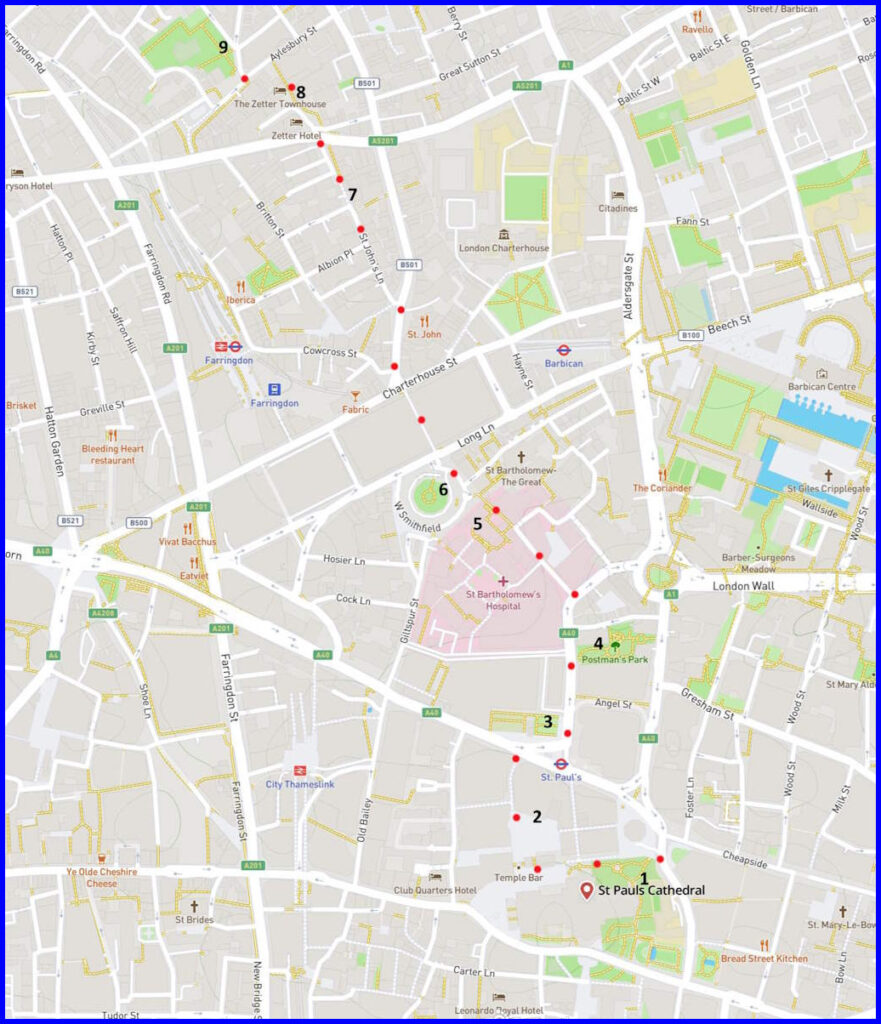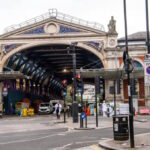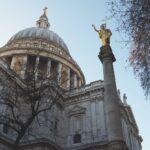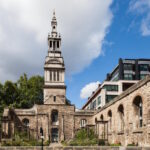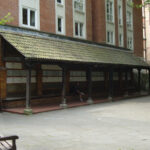There is a GPX route file. If you don’t know about GPX, don’t download it until you have viewed this explanatory video. The slide show below charts the walk by side arrows. Click on maps to enlarge. Click any picture to enlarge. Beneath that are notes on points of interest [Back to Walks page]
1: St Paul’s Cross
In this Elizabethan era this area was the centre of the London book trade. And probably also a gathering place for news and gossip. The cross that was here was a preaching point – or open-air pulpit – during the reformation period. The sermons preached here during the 16th century were vigorous and provocative. Together this would have made the spot a highly important public location at that time – with a long history of political action and religious upheaval.
The current column and memorial is not on the exact spot of the preaching cross – although that spot is marked on the ground just south of the monument. More information is available at this link.
Carry on walking along the pedestrian St Pauls churchyard that skirts the cathedral building. Until finding Temple Bar arch on your right (entrance to Paternoster Square)
2: Temple Bar
Once the gateway to the city of London for 200 years. It was previously removed to the country estate of an English Brewer. It has now been purchased back and painstakingly rebuilt. The entrance (where Strand meets Fleet Street) seems to have been marked in 1293. Its name comes from proximity to the Temple area of lawyers. Elizabeth I came here to celebrate the defeat of the Spanish Armada and was presented with the keys to the city. The ceremony is still carried out here on major state occasions
It is also remembered as a monument to Christopher Wren (although he may not have designed it). On one side the statues are of Charles I and Charles II and on the other James I with his queen. In the 18th century the top of the main arch was used to display the heads of traitors on iron spikes
There is more information at this link. Next, go through into the square and head up to Newgate Street where you see the ruins of Christ Church
3: Christ Church
‘Christ Church Greyfriars’ was originally a 13th century Franciscan monastery but was dissolved by Henry VIII. (The monks wore grey habits). The original church which was the second largest in London. The post-dissolution church was destroyed in the Great Fire. Wren was assigned to reconstruct it. It suffered later from the Blitz and so what is seen today is more of a ruin in a public garden – the tower has been converted into a private residence.
There is more information at this link. After perhaps resting there, walk up King Edward Street to Postman’s Park on your left.
4: Postman’s Park
One of the largest gardens in the City of London and an extraordinary Victorian tribute to ‘humble sacrifice’. The park opened in 1880 on the site of the former churchyard of St Botolphs church. It is perhaps best known as the site of the Watts Memorial. This was opened in 1899. The memorials may moving add tragic reading. Watts was a painter and sculptor and had created a Hall of Fame for the National Portrait Gallery. This was to be a memorial to the bravery of ordinary people.
There is information on the park more generally and the memorial in particular at this link. After resting here, walk down Little Britain towards Smithfield Market
5: St Bartholomew’s
This is the oldest British hospital (900 years old) – popularly known as Barts. If you enter the grounds you might admire the church of St Bartholomew the Less. Do also consider visiting St Bartholomew the Great via Middle Street (at the 3 o clock point off the circular walkway). It is magnificent.
You can learn more about Barts and the area at this link.
After this you can go across the avenue that cuts the market centrally, cross Charterhouse Street, go down St Johns Street and shortly bear left into St Johns Lane towards the Tudor Gatehouse
6: Smithfield Market
Just outside the city walls (and once a grassy area) was Smithfield Market. Long functioning as London’s abattoir, it also is a site of great historical interest. You may see the memorial to William Wallace who was hung drawn and quartered here. Wat Tyler (the Peasants Revolt) was also executed – as were many other heretics and political rebels. The market buildings you see today are late Victorian and their scale is a reflection of the important of the railways for conveying animals to London.
There is more information at this link. Then walk anti clockwise towards the entrance to St Bartholomew’s Hospital. It has the largest cardiac centre in Europe.
8: Tudor Gatehouse
The gate dates from 1504. It once lead to the monastery of St John which was the home of the Knights Hospitaller – who cared for crusaders and pilgrims. Shakespeare got his plays approved here by the Lord Chamberlain. It is worth going in to see the museum of St John – a modern and attractive building.
There is more information regarding St John’s gate at this link. Then walk across Clerkenwell Road and into St Johns Square. Follow the path out of this square towards Aylesbury Street and Clerkenwell Green to the left.
9: Clerkenwell Green
This is the site of St James Church
There is more at this link

